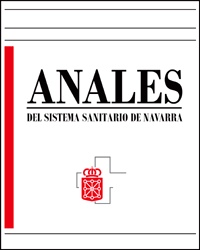Sialoadenitis aguda por administración de contraste yodado
DOI:
https://doi.org/10.23938/ASSN.0950Palabras clave:
Sialoadenitis, Contraste, Yodo, Reacción adversaResumen
La sialoadenitis aguda es una reacción adversa muy poco frecuente a la administración de contraste yodado, que causa una inflamación autolimitada de las glándulas salivales. Su patogenia no está bien establecida, aunque la insuficiencia renal puede ser un factor de riesgo. El diagnóstico es inicialmente clínico, y debe realizarse diagnóstico diferencial con angioedema, infecciones y litiasis. Ningún tratamiento o profilaxis ha demostrado beneficio hasta el momento. Aunque tiene buen pronóstico, en algunos casos se han descrito complicaciones.
Presentamos el caso de un varón de 68 años que presentó inflamación de las glándulas salivales submandibulares tras la realización de una tomografía computarizada abdominal con administración de contraste yodado. Dado el uso creciente de contrastes yodados en pruebas de imagen y técnicas intervencionistas, es importante conocer posibles reacciones adversas como esta entidad.
Descargas
Citas
REDELMAN-SIDI G, MICHIELIN O, CERVERA C, RIBI C, AGUADO JM, FERNÁNDEZ-RUIZ M et al. ESCMID Study Group for Infections in Compromised Hosts (ESGICH) Consensus Document on the safety of targeted and biological therapies: an infectious diseases perspective (Immune checkpoint inhibitors, cell adhesion inhibitors, sphingosine-1-phosphate receptor modulators and proteasome inhibitors). Clin Microbiol Infect 2018; 24 (Suppl 2): S95-S107. https://doi.org/10.1016/j.cmi.2018.01.030
REYNOLDS KL, GUIDON AC. Diagnosis and management of immune checkpoint inhibitor-associated neurologic toxicity: illustrative case and review of the literature. Oncologist 2019; 24: 435-443. https://doi.org/10.1634/theoncologist.2018-0359
MASUDA T, FUJITAKA K, ISHIKAWA N, NAKANO K, YAMASAKI M, KITAGUCHI S et al. Treatment rationale and design of the PROLONG study: Safety and efficacy of pembrolizumab as first-line therapy for elderly patients with non-small cell lung cancer. J Thorac Dis 2020; 12: 1079-1084. https://doi.org/10.21037/jtd.2019.12.46
TOPALIAN SL, HODI FS, BRAHMER JR, GETTINGER SN, SMITH DC, MCDERMOTT DF et al. Safety, activity, and immune correlates of anti-PD-1 antibody in cancer. N Engl J Med 2012; 366: 2443-2454. https://doi.org/10.1056/NEJMoa1200690
MOLINA-GARRIDO MJ, SORIANO RODRÍGUEZ MC, GUILLÉN-PONCE C. ¿Cuál es el papel de la valoración geriátrica integral en Oncogeriatría? Rev Esp Geriatr Gerontol 2019; 54: 27-33. https://doi.org/10.1016/j.regg.2018.07.003
BOSSART S. Case Report: Encephalitis, with brainstem involvement, following checkpoint inhibitor therapy in metastatic melanoma. Oncologist 2017; 22: 749-753. https://doi.org/10.1634/theoncologist.2016-0366
BROWN MP, HISSARIA P, HSIEH AH, KNEEBONE C, VALLAT W. Autoimmune limbic encephalitis with anti-contactin-associated protein-like 2 antibody secondary to pembrolizumab therapy. J Neuroinmunol 2017; 305: 16-18. https://doi.org/10.1016/j.jneuroim. 2016.12.016
NIKI M, NAKAYA A, KURATA T, NAKAHAMA K, YOSHIOKA H, KANEDA T et al. Pembrolizumab-induced autoimmune encephalitis in a patient with advanced non-small cell lung cancer: A case report. Mol Clin Oncol 2019; 10: 267-269. https://doi.org/10.3892/mco.2018.1777
YONEBU Y, ISHIJIMA M, TOYOOKA K, FUJIMURA H. [A case of meningoencephalitis associated with pembrolizumab treated for squamous cell lung cancer]. Clin Neurol 2019; 59: 105-108. https://doi.org/10.5692/clinicalneurol.cn-001218.
SALAM S, LAVIN T, TURAN A. Limbic encephalitis following immunotherapy against metastatic malignant melanoma. BMJ Case Report 2016; 2016: bcr2016215012. https://doi.org/10.1136/bcr-2016-215012
VOGRIG A, FOURET M, JOUBERT B, PICARD G, ROGEMOND V, PINTO AL et al. Increased frequency of anti-Ma2 encephalitis associated with immune checkpoint inhibitors. Neurol Neuroimmunol Neuroinflamm 2019; 6: E604. https://doi.org/10.1212/NXI.00000000000 00604
INOUYE SK, STUDENSKI S, TINETTI ME, KUCHEL GA. Geriatric syndromes: clinical, research, and policy implications of a core geriatric concept. J Am Geriatr Soc 2007; 55: 780-791. https://doi.org/10.1111/j.1532-5415.2007.01156.x
KANAJI N, WATANABE N, KITA N, BANDOH S, TADOKORO A, ISHII T et al. Paraneoplastic syndromes associated with lung cancer. World J Clin Oncol 2014; 5: 197-223. https://doi.org/10.5306/wjco.v5.i3.197
REMON J, LE RHUN E, BESSE B. Leptomeningeal carcinomatosis in non-small cell lung cancer patients: A continuing challenge in the personalized treatment era. Cancer Treat Rev 2017; 53: 128-137. https://doi.org/10.1016/j.ctrv.2016.12.006
BENKE T, WAGNER M, PALLUA AK, MUIGG A, STOCKHAMMER G. Long-term cognitive and MRI findings in a patient with paraneoplastic limbic encephalitis. J Neurooncol 2004; 66: 217-224. https://doi.org/10.1023/b:neon.0000013488.52742.b4
DE OLIVERIA AM, PAULINO MV, VIERA APF, MCKINNEY AM, DA ROCHA AF, DOS SANTOS GT et al. imaging patterns of toxic and metabolic brain disorders. Radiographics 2019; 39: 1672-1695. https://doi.org/10.1148/rg.2019190016
Publicado
Cómo citar
Número
Sección
Licencia
Derechos de autor 2021 Anales del Sistema Sanitario de Navarra

Esta obra está bajo una licencia internacional Creative Commons Atribución-CompartirIgual 4.0.
La revista Anales del Sistema Sanitario de Navarra es publicada por el Departamento de Salud del Gobierno de Navarra (España), quien conserva los derechos patrimoniales (copyright ) sobre el artículo publicado y favorece y permite la difusión del mismo bajo licencia Creative Commons Reconocimiento-CompartirIgual 4.0 Internacional (CC BY-SA 4.0). Esta licencia permite copiar, usar, difundir, transmitir y exponer públicamente el artículo, siempre que siempre que se cite la autoría y la publicación inicial en Anales del Sistema Sanitario de Navarra, y se distinga la existencia de esta licencia de uso.








